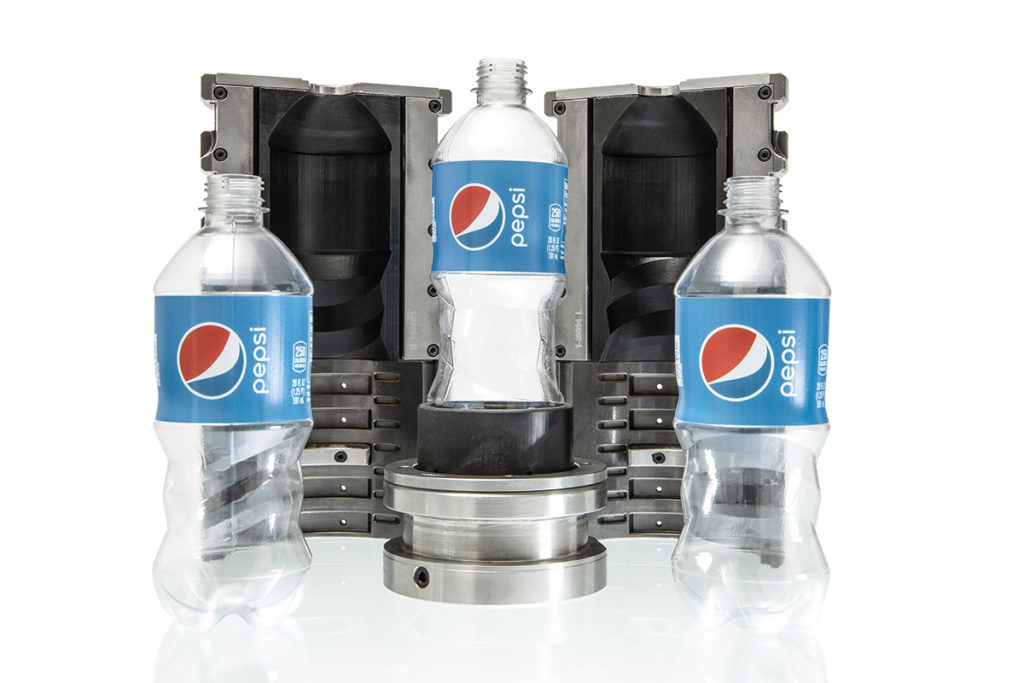CAD to Part in 48 Hours: PepsiCo Slashes Tooling Costs and Cycle Times with the help of NXE 400
PepsiCo worked with Nexa3D’s partner Dynamism to validate the NXE 400 and the xPEEK147 material as ideal for their blow molding application requiring speed and durability.

Iconic PepsiCo Brand Finds Best Alternative to Expensive, Time-Consuming Conventional Metal Tooling
PepsiCo products are enjoyed by consumers more than one billion times a day in more than 200 countries and territories around the world. PepsiCo generated more than $79 billion in net revenue in 2021, driven by a complementary beverage and convenient foods portfolio that includes Lay’s, Doritos, Cheetos, Gatorade, Pepsi-Cola, Mountain Dew, Quaker, and SodaStream. PepsiCo’s product portfolio includes a wide range of enjoyable foods and beverages, including many iconic brands that generate more than $1 billion each in estimated annual retail sales.

The Challenge
Speed to market has never been more important in the consumer goods sector, as brand owners aim to develop new bottle and package designs to address ever-shifting customer desires. But creating conventional metal tooling for the blow molding of bottles is an expensive and time-consuming proposition. Once a CAD file of the package design is created, it can take up to four weeks to machine a metal tool, and then an additional two weeks to get a trial unit to do the actual blow molding. It also could easily cost up to $10,000 to produce a single metal tool set depending on its complexity, according to Max Rodriguez, senior manager of Global Packaging R&D, Advanced Engineering and Design, at PepsiCo’s Valhalla research center.
This has led many to try to apply 3D printing to shorten this process, but previous rapid tooling approaches also had their shortcomings. It would take two to three days to 3D print a single blow molding tool from Digital ABS (an expensive material) on a $250,000 PolyJet 3D printing machine. Even so, the resulting tool lacked durability and could produce only about 100 bottles before the mold began to fail. This prompted Rodriguez and his team to explore using a hybrid approach, combining parts of a conventional metal mold with 3D printed inserts.
“Time and cost are obviously important, but more important is to have the ability to have the flexibility to run through a number of different design iterations at a record pace so that we can evaluate performance in all of the downstream activities. That really is what helps us accelerate packaging design and development.”
Max Rodriguez
Senior Manager of Global Packaging
R&D, Advanced Engineering and Design, PepsiCo
Company
PepsiCo Inc.
Industry
Consumer goods packaging, food & beverage
Printer
Nexa3D NXE 400 Printer
Material
xPEEK147 by Henkel Loctite
Application
Applying its patented technology and a hybrid approach, PepsiCo is using additive manufacturing as an enabler in various aspects of bottle development – accelerating and enhancing performance simulation, advanced system analysis and the production of high-quality, functional prototypes.
Advantages
- Compress prototype tooling development time from 4 weeks to 48 hours
- Slash prototype tooling costs from $10,000 to $350 per mold set
- Create durable tooling that can produce more than 10,000 bottles per mold
- Enable multiple design iterations to allow for timely verification of downstream activities


More Than 10,000 Bottles at 96% Reduction in Cost
PepsiCo chose Nexa3D’s xPEEK147 from Henkel Loctite for the 3D printed tool inserts due to the material’s strength and impressive performance factors, including its very high heat-deflection temperature. While this hybrid approach is machine-agnostic, meaning it can use various types of 3D printers, PepsiCo has found the ultrafast, high-throughput Nexa3D NXE 400 3D printer and accompanying material performance to be ideal for producing the mold components it needs.
A complete mold set can be made in 12 hours, with 8 hours of 3D printing time and 4 hours of curing. These hybrid-made molds can then successfully be used for more than 10,000 bottles before failure – at up to a 96% reduction of cost compared to traditional metal tooling.
Download Case Study

